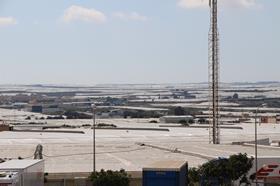
Beneath Almería’s 30,000-ha sea of plastic lies one of the most technologically advanced horticultural industries in the world. Luis Martín Garvayo, commercial manager, vegetable seeds Iberia at Syngenta, discusses the challenges and opportunities facing the region’s producers.
What would you say are the main challenges facing Almería’s horticultural sector today?
Luis Martin Garvayo: Most people in the sector would tell you that the biggest issue is price volatility. But in my opinion, the great challenge of Almerian agriculture today is to make certain sectors of society aware of what it has achieved. There is still a large part of society – most of it urban – which does not understand that what has enabled Almería to become a true powerhouse in European horticulture in the application of new technologies in plant genetics and integrated crop management, as well as the true professionalism of the sector.
 Will Syngenta’s acquisition by ChemChina have any impact on your business in Almeria? Will there be any opportunity for the region to take advantage of the synergies that will be created?
Will Syngenta’s acquisition by ChemChina have any impact on your business in Almeria? Will there be any opportunity for the region to take advantage of the synergies that will be created?
LMG: The deal opens many opportunities and our new owners are fully aware of Syngenta’s innovative potential. They are also conscious of vital role that agritech plays in achieving a more sustainable agricultural model that meets the challenges of food security. Syngenta brings them precisely that, the technologies to produce more with less and with a commitment to do so in a more sustainable way. Almería is currently leading the way in the application of sustainable intensive farming practices and the region is home to the leading experts in plant sciences. It’s not for nothing that they call it horticulture’s Silicon Valley. So our fusion with ChemChina will create inevitable synergies.
What are consumers demanding right now?
LMG: In terms of consumer trends, things haven’t changed that much in recent years, taste being the main requirement of the market. We are also seeing a big raise in convenience formats such as ready-to-eat and snack segments.
In this sector, where innovation trumps all, the challenge is not only to satisfy the needs of the consumer, but also those of every stage of the agri-food chain. When it comes to developing a new variety, we have to take into account that the producer wants high productivity and resistance to pests and diseases, while exporters require a long shelf-life and retailers want to ensure they receive safe, residue-free products.
We’re seeing more consolidation than ever at every level of the supply chain. What does this mean for producers?
LMG: Consolidation does not necessarily have to mean new ways of working, so I’m not sure that producers are facing radical changes. What’s important is to ensure that this consolidation does not impede competition and that dynamism is allowed to flourish so that the industry can continue to expand its offer and generate innovative solutions. Let’s not forget that consolidation brings benefits in helping to simplify the supply chain and reduce the complexity of the sector generally.
Producing more food with fewer resources is a formidable challenge. Do you think there is sufficient collaboration between the various links of the chain to achieve this goal?
LMG: Undoubtedly, the industry could always do more to improve sustainability, although in recent years things have been getting better. In Syngenta’s case we are now in the fourth year of The Good Growth Plan, which comprises six ambitious commitments for 2020 to support the sustainability of agriculture and the development of rural communities. Today the project spans more than 3,600 producers across the globe. In Spain alone, our commitment to improve biodiversity now covers more than 3,000ha of intensive production.



